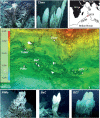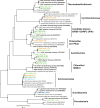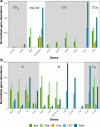Microbial ecology of the newly discovered serpentinite-hosted Old City hydrothermal field (southwest Indian ridge)
- PMID: 33139872
- PMCID: PMC8027613
- DOI: 10.1038/s41396-020-00816-7
Microbial ecology of the newly discovered serpentinite-hosted Old City hydrothermal field (southwest Indian ridge)
Abstract
Lost City (mid-Atlantic ridge) is a unique oceanic hydrothermal field where carbonate-brucite chimneys are colonized by a single phylotype of archaeal Methanosarcinales, as well as sulfur- and methane-metabolizing bacteria. So far, only one submarine analog of Lost City has been characterized, the Prony Bay hydrothermal field (New Caledonia), which nonetheless shows more microbiological similarities with ecosystems associated with continental ophiolites. This study presents the microbial ecology of the 'Lost City'-type Old City hydrothermal field, recently discovered along the southwest Indian ridge. Five carbonate-brucite chimneys were sampled and subjected to mineralogical and geochemical analyses, microimaging, as well as 16S rRNA-encoding gene and metagenomic sequencing. Dominant taxa and metabolisms vary between chimneys, in conjunction with the predicted redox state, while potential formate- and CO-metabolizing microorganisms as well as sulfur-metabolizing bacteria are always abundant. We hypothesize that the variable environmental conditions resulting from the slow and diffuse hydrothermal fluid discharge that currently characterizes Old City could lead to different microbial populations between chimneys that utilize CO and formate differently as carbon or electron sources. Old City discovery and this first description of its microbial ecology opens up attractive perspectives for understanding environmental factors shaping communities and metabolisms in oceanic serpentinite-hosted ecosystems.
Conflict of interest statement
The authors declare that they have no conflict of interest.
Figures








Similar articles
-
Microbial ecology of serpentinite-hosted ecosystems.ISME J. 2025 Jan 2;19(1):wraf029. doi: 10.1093/ismejo/wraf029. ISME J. 2025. PMID: 39961017 Free PMC article. Review.
-
Record of archaeal activity at the serpentinite-hosted Lost City Hydrothermal Field.Geobiology. 2013 Nov;11(6):570-92. doi: 10.1111/gbi.12062. Geobiology. 2013. PMID: 24118888
-
Methane- and sulfur-metabolizing microbial communities dominate the Lost City hydrothermal field ecosystem.Appl Environ Microbiol. 2006 Sep;72(9):6257-70. doi: 10.1128/AEM.00574-06. Appl Environ Microbiol. 2006. PMID: 16957253 Free PMC article.
-
Archaea and bacteria with surprising microdiversity show shifts in dominance over 1,000-year time scales in hydrothermal chimneys.Proc Natl Acad Sci U S A. 2010 Jan 26;107(4):1612-7. doi: 10.1073/pnas.0905369107. Epub 2010 Jan 11. Proc Natl Acad Sci U S A. 2010. PMID: 20080654 Free PMC article.
-
The production of methane, hydrogen, and organic compounds in ultramafic-hosted hydrothermal vents of the Mid-Atlantic Ridge.Astrobiology. 2015 May;15(5):381-99. doi: 10.1089/ast.2014.1198. Astrobiology. 2015. PMID: 25984920 Free PMC article. Review.
Cited by
-
Metabolic challenges and key players in serpentinite-hosted microbial ecosystems.Front Microbiol. 2023 Jul 24;14:1197823. doi: 10.3389/fmicb.2023.1197823. eCollection 2023. Front Microbiol. 2023. PMID: 37555067 Free PMC article. Review.
-
Microbial Abundance and Diversity in Subsurface Lower Oceanic Crust at Atlantis Bank, Southwest Indian Ridge.Appl Environ Microbiol. 2021 Oct 28;87(22):e0151921. doi: 10.1128/AEM.01519-21. Epub 2021 Sep 1. Appl Environ Microbiol. 2021. PMID: 34469194 Free PMC article.
-
Quantifying the effects of hydrogen on carbon assimilation in a seafloor microbial community associated with ultramafic rocks.ISME J. 2022 Jan;16(1):257-271. doi: 10.1038/s41396-021-01066-x. Epub 2021 Jul 26. ISME J. 2022. PMID: 34312482 Free PMC article.
-
Serpentinization as the source of energy, electrons, organics, catalysts, nutrients and pH gradients for the origin of LUCA and life.Front Microbiol. 2023 Oct 2;14:1257597. doi: 10.3389/fmicb.2023.1257597. eCollection 2023. Front Microbiol. 2023. PMID: 37854333 Free PMC article. Review.
-
Microbial ecology of serpentinite-hosted ecosystems.ISME J. 2025 Jan 2;19(1):wraf029. doi: 10.1093/ismejo/wraf029. ISME J. 2025. PMID: 39961017 Free PMC article. Review.
References
-
- Proskurowski G, Lilley MD, Seewald JS, Früh-Green GL, Olson EJ, Lupton JE, et al. Abiogenic hydrocarbon production at Lost City hydrothermal field. Science. 2008;319:604–7. - PubMed
-
- Kelley DS, Lilley MD, Früh‐Green GL. Volatiles in submarine environments: food for life. In: Wilcock WSD, Delong EF, Kelley DS, Baross JA, Cary SC, editors. The subseafloor biosphere at mid-ocean ridges. Geophysical monograph, vol 144. Washington DC: American Geophysical Union; 2004. p. 167–89.
-
- Schrenk MO, Brazelton WJ, Lang SQ. Serpentinization, carbon, and deep life. In: Hazen RM, Jones AP, Baross JA, editors. Carbon in earth. Reviews in mineralogy and geochemistry, vol 75. Chantilly, VA: Mineralogical Society of America; 2013. p. 575–606.
-
- Cannat M, Mével C, Maia M, Deplus C, Durand C, Gente P, et al. Thin crust, ultramafic exposures, and rugged faulting patterns at the Mid-Atlantic Ridge (22°–24°N) Geology. 1995;23:49–52.
-
- Cannat M, Sauter D, Mendel V, Ruellan E, Okino K, Escartin J, et al. Modes of seafloor generation at a melt-poor ultraslow-spreading ridge. Geology. 2006;34:605–8.

